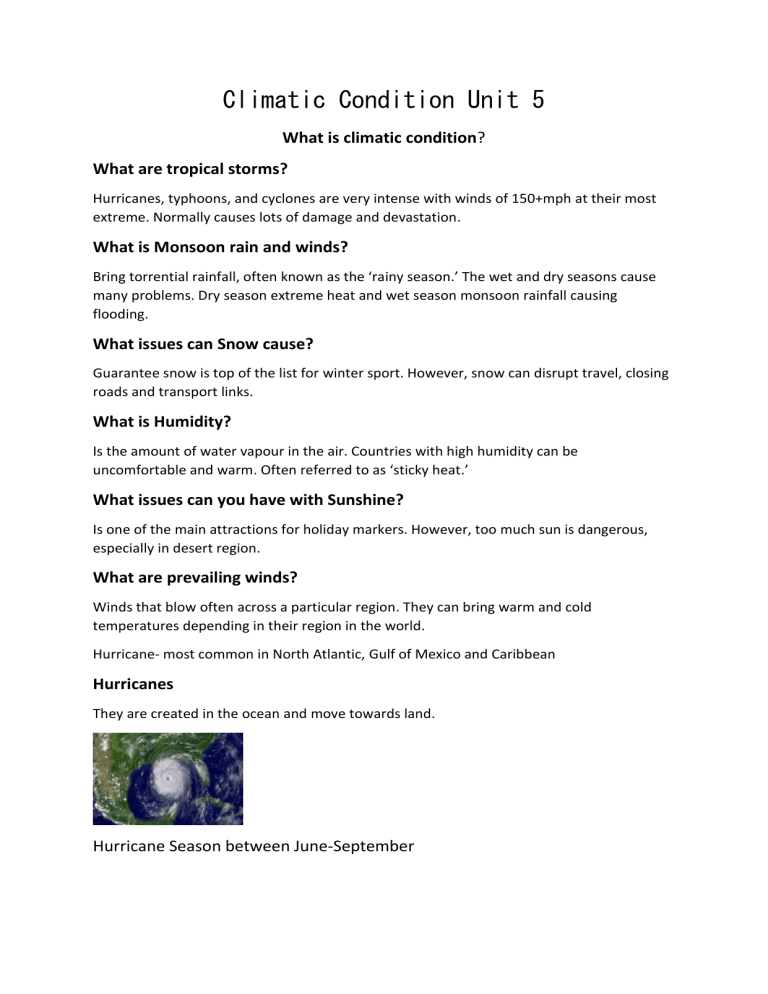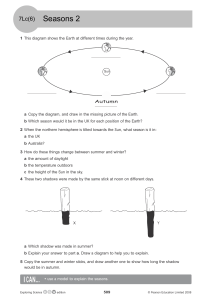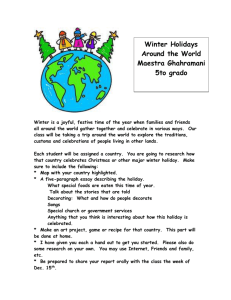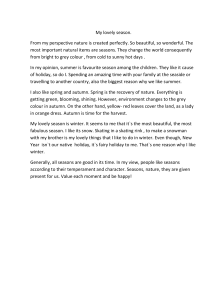
Climatic Condition Unit 5 What is climatic condition? What are tropical storms? Hurricanes, typhoons, and cyclones are very intense with winds of 150+mph at their most extreme. Normally causes lots of damage and devastation. What is Monsoon rain and winds? Bring torrential rainfall, often known as the ‘rainy season.’ The wet and dry seasons cause many problems. Dry season extreme heat and wet season monsoon rainfall causing flooding. What issues can Snow cause? Guarantee snow is top of the list for winter sport. However, snow can disrupt travel, closing roads and transport links. What is Humidity? Is the amount of water vapour in the air. Countries with high humidity can be uncomfortable and warm. Often referred to as ‘sticky heat.’ What issues can you have with Sunshine? Is one of the main attractions for holiday markers. However, too much sun is dangerous, especially in desert region. What are prevailing winds? Winds that blow often across a particular region. They can bring warm and cold temperatures depending in their region in the world. Hurricane- most common in North Atlantic, Gulf of Mexico and Caribbean Hurricanes They are created in the ocean and move towards land. Hurricane Season between June-September Cyclone- in southwest Pacific Ocean What is the difference between Hurricane, typhoons, and cyclones? Well, they are all the same thing, but are given different names depending on where they appear. Hurricanes are tropical storms that form over the North Atlantic Ocean and Northeast Pacific and Indian Ocean. Typhoons are formed over the Northwest Pacific Ocean. Cyclones are formed over the south Pacific and Indian Ocean. Seasonal variations What is seasonal weather? There are four types of seasons on earth: spring, autumn, winter, and summer. When planning a holiday, it is worth finding out whether extreme climatic conditions are seasonal and decide best times to travel for favourable conditions. Locations and times of year to avoid. What and where do we get Tropical storms? Tropical storms have district seasons depending on their location. Hurricane and typhoon seasons are between June-November. Cyclone season is November-March. The Caribbean and Florida are popular holiday destinations. Some visitors will avoid planning a holiday to high-risk destination like during hurricane season. Indian Ocean and Asian contributes like India are affected by monsoon wet season from June-September. 80% of India’s rain falls during the wet season. Locations and times of year with favourable condition The Mediterranean has some of the most favourable conditions for British sun seekers. Spring and Summer can be pleasant with temperatures suited to young families. You must travel further south to the Canary Islands and other countries at a similar latitude for year-round sunshine. Snow is also seasonal. It normally occurs at high altitude in mountain regions of Europe and Northern hemisphere during winter mouths of November-March. European alpine continues and Scandinavia are good locations for holiday makers who Ski. Where is the northern Hemisphere? Northern and Southern Hemisphere Locations in respect of global aspects As the name suggests, tropical storms are found in tropical areas, around the Tropic of cancer in the Northern hemisphere and the Tropic of Capricorn in Southern hemisphere. Countries around the Equator are the hottest, too hot for holiday makers normally. Polar regions are too cold and have ice all year round apart from polar exhibitions. Do not forget how seasons vary in northern and southern hemispheres. In Australia you could be sweltering on a beach on Christmas day but in London you could have Snow. Locations in respect of global aspects I am going to discuss the difference. Seasonal variation. These are four types of seasons on earth: - spring, autumn, winter, and summer. When planning a holiday, it is worth finding out whether extreme climate conditions are seasonal and decide best times to travel for favourable conditions. Countries a Introduction Topic a.1 climate conditions affecting the appeal of travel and tourism. I will write about the different climate conditions and seasonal variations and how they can affect the appeal of x2 European and x2 worldwide travel destinations, including potential effects on travel to destinations. I will than compare the different climate conditions and seasonal variations and consider their effect on different climate condition and seasonal variations and consider their effect on different destinations and their visitors. Europe: Germany, Italy Worldwide: Brazil, Dubai Germany Germany is in the Central of Europe, is in the Northern and Eastern hemisphere, Germany is not closed to the equator, however, is closed to north of tropic of cancer. Temperatures in summer are regularly 23–37-degree C. However, in Berlin (the capital city of Germany) it is much hotter than the rest of the world. Berlin is heavy with humidity and the lack of air conditioning means there are few places to escape. The winter mouths can get very cold in Germany, with temperatures often drop to zero degrees or even bellow, offering a wonderful opportunity for Germany to host winter sports for example alpine skiing, winter hiking, cross country skiing, this are a part of sports that are practice in Germany when is winter. These are the most popular sports. Also, some parts of Germany have white Christmas, and this means they will have Christmas Markets which are extremely popular, because they have white Christmas it looks like a dream which means it will attract visitors which will brave the cold just to visit the market. As you might think about the snow and the white Christmas it also might rain and you should be ready for it. In December, the temperature can be between 0°C and 5°C. Also, this month of the year is the more frequent to have rainy days. In January, the temperature varies by several degrees around the country, with lows of -3°C in Munich and 0°C in Hamburg. On average, Germany has a temperature of 3°C in January. In summer there are sunny days, with the temperatures between 23 degrees C but some days the temperature can top up to 37-degree C. The summer mouths are also the highest in Germany. Also, the hottest part of it is in South. Average Temperatures: June: 22°C, but this may rise by four or five degrees in hotspots away from the coast. The heat and humidity levels are high and so is the UV index, so take care in the sun. July: Temperatures could reach the high twenties and the average of 24°C shows how brilliant the weather in Germany in July is. August: The average temperatures over 20°C throughout the country, from Hamburg in the north to Munich in the south. Germany can get tornadoes around 10-25 per year many of these are weak events. Severe tornadoes, leading to major destruction and loss of life. Italy Italy is a short-haul destination and is in Europe and both the eastern and northern hemispheres is in Southern Europe comprising the boot-shaped Italian peninsula and several islands including Sicily and Sardinia. Neighbouring counties include Austria, France, Holly See, San Marino, Slovenia, and Switzerland. It is in the north of the topic of cancer. Italy is known for its warm, Mediterranean climate. Summers are always hot, sunny, and dry while winters are cooler with an increased chance of rain. The weather varies slightly depending on where you are in Italy. Usually, the summer in Italy is on average 24°C. Temperatures are much hotter during the day than at night. The winters are icy dropping down two digits. The Spring months are April to May, the Autumn months are September to October, the Winter months are December January and February, and the summer months are May to August. Because Italy is a country with a diverse relief the temperature can differ from where you are if you are on the coast or in the mountain. The most popular sports that Italy hosts are skiing and snowboarding. Italy is visited all year round by the tourists because is a country with a perfect climate all year round and things to do. Also, is perfect for doing your hobbies or even taking part in sports. The best thing is that you can go to ski in the winter or go to the beach on the summer. The winter and autumn are very great for visiting monuments, having long walks, or even taking parts in sports. However, as nice as it sounds sometimes in winter can sow too much which might have an impact on the tourism industry for example if people booked a holiday in Italy and the snow appears later the tourists may not ski.




